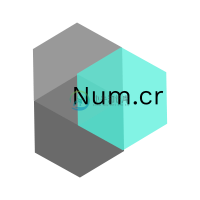Num.cr is the core shard needed for scientific computing with Crystal
- Website: https://crystal-data.github.io/num.cr
- API Documentation: https://crystal-data.github.io/num.cr/
- Source code: https://github.com/crystal-data/num.cr
- Bug reports: https://github.com/crystal-data/num.cr/issues
It provides:
- An n-dimensional
Tensordata structure - Efficient
map,reduceandaccumulateroutines - GPU accelerated routines backed by
OpenCL - Linear algebra routines backed by
LAPACKandBLAS
Prerequisites
Num.cr aims to be a scientific computing library written in pure Crystal.All standard operations and data structures are written in Crystal. Certainroutines, primarily linear algebra routines, are instead provided by aBLAS or LAPACK implementation.
Several implementations can be used, including Cblas, Openblas, and theAccelerate framework on Darwin systems. For GPU accelerated BLAS routines,the ClBlast library is required.
Num.cr also supports Tensors stored on a GPU. This is currently limitedto OpenCL, and a valid OpenCL installation and device(s) are required.
Installation
Add this to your applications shard.yml
dependencies:
num:
github: crystal-data/num.cr
Several third-party libraries are required to use certain features of Num.cr.They are:
- BLAS
- LAPACK
- OpenCL
- ClBlast
While not at all required, they provide additional functionality than isprovided by the basic library.
Just show me the code
The core data structure implemented by Num.cr is the Tensor, an N-dimensionaldata structure. A Tensor supports slicing, mutation, permutation, reduction,and accumulation. A Tensor can be a view of another Tensor, and can supporteither C-style or Fortran-style storage.
Creation
There are many ways to initialize a Tensor. Most creation methods canallocate a Tensor backed by either CPU or GPU based storage.
[1, 2, 3].to_tensor
Tensor.from_array [1, 2, 3]
Tensor(UInt8).zeros([3, 3, 2])
Tensor.random(0.0...1.0, [2, 2, 2])
ClTensor(Float32).zeros([3, 2, 2])
ClTensor(Float64).full([3, 4, 5], 3.8)
Operations
A Tensor supports a wide variety of numerical operations. Many of theseoperations are provided by Num.cr, but any operation can be mapped acrossone or more Tensors using sophisticated broadcasted mapping routines.
a = [1, 2, 3, 4].to_tensor
b = [[3, 4, 5, 6], [5, 6, 7, 8]].to_tensor
# Convert a Tensor to a GPU backed Tensor
acl = a.astype(Float64).gpu
puts Num.add(a, b)
# a is broadcast to b's shape
# [[ 4, 6, 8, 10],
# [ 6, 8, 10, 12]]
When operating on more than two Tensors, it is recommended to use maprather than builtin functions to avoid the allocation of intermediateresults. All map operations support broadcasting.
a = [1, 2, 3, 4].to_tensor
b = [[3, 4, 5, 6], [5, 6, 7, 8]].to_tensor
c = [3, 5, 7, 9].to_tensor
a.map(b, c) do |i, j, k|
i + 2 / j + k * 3.5
end
# [[12.1667, 20 , 27.9 , 35.8333],
# [11.9 , 19.8333, 27.7857, 35.75 ]]
Mutation
Tensors support flexible slicing and mutation operations. Many of theseoperations return views, not copies, so any changes made to the results mightalso be reflected in the parent.
a = Tensor.new([3, 2, 2]) { |i| i }
puts a.transpose
# [[[ 0, 4, 8],
# [ 2, 6, 10]],
#
# [[ 1, 5, 9],
# [ 3, 7, 11]]]
puts a.reshape(6, 2)
# [[ 0, 1],
# [ 2, 3],
# [ 4, 5],
# [ 6, 7],
# [ 8, 9],
# [10, 11]]
puts a[..., 1]
# [[ 2, 3],
# [ 6, 7],
# [10, 11]]
puts a[1..., {..., -1}]
# [[[ 6, 7],
# [ 4, 5]],
#
# [[10, 11],
# [ 8, 9]]]
puts a[0, 1, 1].value
# 3
Linear Algebra
Tensors provide easy access to power Linear Algebra routines backed byLAPACK and BLAS implementations, and ClBlast for GPU backed Tensors.
a = [[1, 2], [3, 4]].to_tensor.map &.to_f32
puts a.inv
# [[-2 , 1 ],
# [1.5 , -0.5]]
puts a.eigvals
# [-0.372281, 5.37228 ]
acl = a.opencl
bcl = a.opencl
puts acl.gemm(bcl).cpu
# [[7 , 10],
# [15, 22]]
puts a.matmul(a)
# [[7 , 10],
# [15, 22]]
Machine Learning
Num::Grad provides a pure-crystal approach to find derivatives ofmathematical functions. Use a Num::Grad::Variable with a Num::Grad::Contextto easily compute these derivatives.
ctx = Num::Grad::Context(Tensor(Float64)).new
x = ctx.variable([3.0])
y = ctx.variable([2.0])
# f(x) = x ** y
f = x ** y
puts f # => [9]
f.backprop
# df/dx = y * x = 6.0
puts x.grad # => [6.0]
Num::NN contains an extension to Num::Grad that provides an easy-to-useinterface to assist in creating neural networks. Designing and creatinga network is simple using Crystal's block syntax.
ctx = Num::Grad::Context(Tensor(Float64)).new
x_train = [[0.0, 0.0], [1.0, 0.0], [0.0, 1.0], [1.0, 1.0]].to_tensor
y_train = [[0.0], [1.0], [1.0], [0.0]].to_tensor
x = ctx.variable(x_train)
net = Num::NN::Network.new(ctx) do
input [2]
# A basic network with a single hidden layer using
# a ReLU activation function
linear 3
relu
linear 1
# SGD Optimizer
sgd 0.7
# Sigmoid Cross Entropy to calculate loss
sigmoid_cross_entropy_loss
end
500.times do |epoch|
y_pred = net.forward(x)
loss = net.loss(y_pred, y_train)
puts "Epoch: #{epoch} - Loss #{loss}"
loss.backprop
net.optimizer.update
end
# Clip results to make a prediction
puts net.forward(x).value.map { |el| el > 0 ? 1 : 0}
# [[0],
# [1],
# [1],
# [0]]
Review the documentation for full implementation details, and if something is missing,open an issue to add it!
-
CREATEDEFINER=`rootdba`@`%`PROCEDURE`case_30day_ser4`(OUTout_flagINT,out_tableVARCHAR(200))BEGINDECLAREcr_stack_depthINTEGERDEFAULTcr_debug.ENTER_MODULE2('case_30day_ser4... CREATE DEFINER=`rootdba`@`
-
需要逐类对预测结果进行分析。 相关代码地址:https://github.com/Xingxiangrui/multi_label_analyse 目录 一、结果读出 1.1 写出结果 1.2 结果读出 二、运算指标 2.1 指标与print 2.2 指标的运算 2.3 输出 三、precision,recall,F1 3.1 定义函数进行运算 3.2 函数的调用 3.3 运行结果 一、结果读出
-
专业维修销售柯马C0MAC机器人,控制柜,主机,CPU板,伺服放大器,主板,I/O板,示教器,伺服马达,电路板等全新二手原装,同时还提供三小时廉价快修,全系列机器人测试平台,免费提供技术咨询。 COMAU CR82309060、CR82309061、CR82309062、CR82309063、CR82309064、CR82309065、CR82309066、CR82309067,COMAU机器人电


